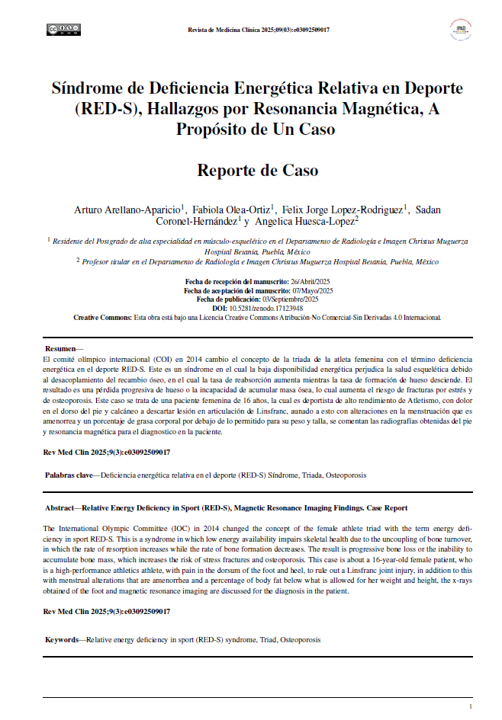Resumen
El comité olímpico internacional (COI) en 2014 cambio el concepto de la triada de la atleta femenina con el término deficiencia energética en el deporte RED-S. Este es un síndrome en el cual la baja disponibilidad energética perjudica la salud esquelética debido al desacoplamiento del recambio óseo, en el cual la tasa de reabsorción aumenta mientras la tasa de formación de hueso desciende. El resultado es una pérdida progresiva de hueso o la incapacidad de acumular masa ósea, lo cual aumenta el riesgo de fracturas por estrés y de osteoporosis. Este caso se trata de una paciente femenina de 16 años, la cual es deportista de alto rendimiento de Atletismo, con dolor en el dorso del pie y calcáneo a descartar lesión en articulación de Linsfranc, aunado a esto con alteraciones en la menstruación que es amenorrea y un porcentaje de grasa corporal por debajo de lo permitido para su peso y talla, se comentan las radiografías obtenidas del pie y resonancia magnética para el diagnostico en la paciente.
Referencias
Ferreira ALHA, Silva CAV, Prata CR de S, Vinhas CB, Neves MG. Conhecimento, triagem, consequências e prevalência dos sintomas da síndrome da tríade da mulher atleta/ deficiência relativa de energia no esporte (RES-S): uma revisão integrativa. Brazilian Journal of Health Review. 2024 Aug 8;7(4):e71788.
Carvalho Thiers Cakazabs AP , Emília C, Bonjorno G. Aspectos nutricionaliis en atletas acometidos pela síndrome da deficiencia energetica relativa no esporte (RED-S). Ensaios USF. 2023 Aug 1;7(1).
Coelho AR, Cardoso G, Brito ME, Gomes IN, Cascais MJ. The Female Athlete Triad/Relative Energy Deficiency in Sports (RED-S). Revista Brasileira de Ginecologia e Obstetrícia / RBGO Gynecology and Obstetrics. 2021 May 2;43(05):395–402.
Wasserfurth P, Palmowski J, Hahn A, Krüger K. Reasons for and Consequences of Low Energy Availability in Female and Male Athletes: Social Environment, Adaptations, and Prevention. Sports Med Open. 2020 Dec 10;6(1):44.
Cabre HE, Moore SR, Smith-Ryan AE, Hackney AC. Relative Energy Deficiency in Sport (RED-S): Scientific, Clinical, and Practical Implications for the Female Athlete. Dtsch Z Sportmed. 2022;73(7):225–34.
Hackney AC, Moore SR, Smith-Ryan A. Low Energy Availability, Carbohydrate Intake, and Relative Energy Deficiency in Sport: The Low Triiodothyronine Hypothesis. Int J Sports Physiol Perform. 2025;1–4.
Robertson S, Mountjoy M. A Review of Prevention, Diagnosis, and Treatment of Relative Energy Deficiency in Sport in Artistic (Synchronized) Swimming. Int J Sport Nutr Exerc Metab. 2018 Jul 1;28(4):375–84.
Pepper M, Akuthota V, McCarty EC. The Pathophysiology of Stress Fractures. Clin Sports Med. 2006 Jan;25(1):1–16.
Grande del Arco J. Fracturas de estrés en atletas. Revista Internacional de Ciencias Podológicas. 1970 Jan 1;12(2).
Schroeder JD, Trigg SD, Capo Dosal GE. Bone Stress Injuries: Diagnosis and Management. Am Fam Physician. 2024 Dec;110(6):592–600.
Sesbreno E, Dziedzic C, Blondin DP, Kennedy C, Sygo J, Haman F, et al. The association between the risk of relative energy deficiency in sports and performance outcomes: A real-world examination of international elite volleyball male athletes. J Sports Sci. 2025 Aug 18;43(16):1665–74.
Schiappacasse F G, Díaz J J, Alvayay Q P. Protocolo abreviado de resonancia magnética en espondiloartritis: más allá de la sacroileítis. Rev Med Chil. 2015 Jul;143(7):905–12.
Mountjoy M, Ackerman KE, Bailey DM, Burke LM, Constantini N, Hackney AC, et al. Avoiding the “REDs Card”. We all have a role in the mitigation of REDs in athletes. Br J Sports Med. 2023 Sep;57(17):1063–4.

Esta obra está bajo una licencia internacional Creative Commons Atribución-NoComercial-SinDerivadas 4.0.
Derechos de autor 2025 Arturo Arellano-Aparicio, Fabiola Olea-Ortiz, Felix Jorge Lopez-Rodriguez; Sadan Coronel-Hernández; Angelica Huesca-Lopez

